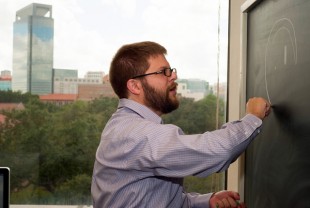MEDIA CONTACTS:
B.J. Almond
713-348-6770
balmond@rice.edu
Jade Boyd
713-348-6778
jadeboyd@rice.edu
Doubly honored: Two prestigious awards for Rice’s Putman
Rice mathematician earns Sloan Research Fellowship and NSF CAREER Award
HOUSTON — (Feb. 18, 2013) — Rice University mathematician Andrew Putman has earned two of the nation’s most prestigious honors for young scientists: a Sloan Research Fellowship and a CAREER Award from the National Science Foundation.
“I’m honored and grateful to receive the support,” said Putman, the Edgar Odell Lovett Assistant Professor of Mathematics at Rice. “I have plans for a number of research projects, and we’ll also use some of these funds to establish a summer mathematics program here at Rice for disadvantaged high school students from the Houston public schools.”
Both Sloan Research Fellowships and NSF CAREER Awards are designed to help advance early career researchers who are poised to make a significant impact in their discipline. Sloan Research Fellows receive a two-year, $50,000 grant that may be used in a largely unrestricted manner. The fellowships are highly sought, due both to the lack of restrictions on the funds and the prestige of the awards, which were established in 1955. The NSF CAREER Award, which includes a $500,000, five-year grant, is equally competitive: NSF awards fewer than 400 each year across all scientific and engineering disciplines.
Putman, who joined Rice’s faculty in 2010, earned his bachelor’s degree in mathematics from Rice in 2002 and his doctorate from the University of Chicago in 2007. He specializes in low-dimensional topology and geometric group theory.
“I first met Dr. Putman in 2002, when I was a new assistant professor and he was an undergraduate taking my first graduate course at Rice,” said Brendan Hassett, professor and chair of the Department of Mathematics. “I didn’t realize at the time that in just eight years he would be joining us as a colleague. In those years, he resolved mathematical problems that have been open for decades and established himself as an international authority on the Torelli group — an algebraic measure of all the different ways to twist a surface, like licorice. We all feel great pride at his accomplishments, both as a colleague and a graduate of Rice.
Putman said his research aims to uncover fundamental similarities between geometric shapes.
“One of the insights of 20th-century mathematics is that many geometric questions come down in the end to the presence or absence of different kinds of symmetries,” Putman said. “So I’m interested in geometric questions, but the way I look at them is through the study of group theory, which, loosely speaking, is the study of symmetries.”
A group is a mathematical object that encodes symmetries. The same group can be used to describe objects that might, at first glance, appear to be very different. A famous example of this is the doughnut and the coffee cup. Though the cup appears to be wholly different from the doughnut, each is a ring of material with a hole. In the cup’s case, the hole is the empty space encircled by the handle. A topologist, a geometry expert who studies shapes called manifolds, can use a single set of equations to accurately describe both the cup and the doughnut.
“We live in a three-dimensional world, and as humans, we want to understand three-dimensional spaces,” Putman said. “I think the deepest work done in geometry in my lifetime was the work of Bill Thurston, who was my mathematical grandfather — my Ph.D.’s adviser’s adviser. Thurston used geometry to classify all three-dimensional manifolds, which was shocking. I mean, in the topological example of the doughnut and the coffee cup, it looks like there is no intrinsic shape, distances or angles; they look completely different. But Thurston showed that there are intrinsic geometries hidden inside all three-dimensional spaces. I can deform it and stretch it out, but it turns out, miraculously, that there’s a unique, best geometry for most three-dimensional manifolds. It doesn’t depend on any choices at all. That is remarkable. It was a fundamental discovery, and it just opened the door. My work focuses on different kinds of objects, but it is thoroughly permeated by Thurston’s point of view.”
Putman said his research is also about basic, fundamental discovery.
“Mathematics, especially geometry, has lots of connections to the physical sciences, but that’s not really what motivates me,” Putman said. “I’m interested in math for aesthetic reasons. It’s something that I find intrinsically beautiful. This is basic science.
“Sometimes we’re really lucky and math turns out to be useful in some way,” he said. “For example, a lot of the things that allow the Internet to function weren’t found because someone said, ‘I want to solve this problem’ about data security or whatever. People spent more than 100 years developing the basic mathematics that later enabled data encryption and other technologies. Consequently, those things were already in place when they were needed.”
And the wellspring of mathematical ideas is far from dry.
“There has been more new math discovered in the last 30 years than in all previous human history,” he said.
###
High-resolution IMAGES are available for download at:
https://news2.rice.edu/files/2013/02/Putman-1.jpg
CAPTION: Andrew Putman
CREDIT: Tommy LaVergne/Rice University


